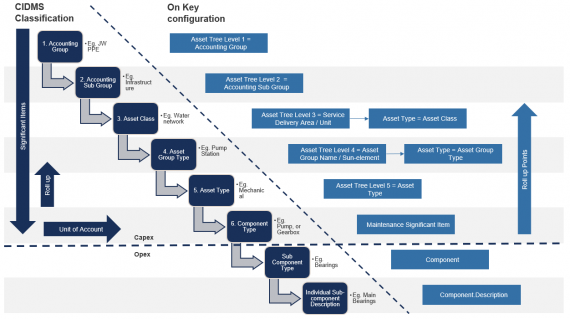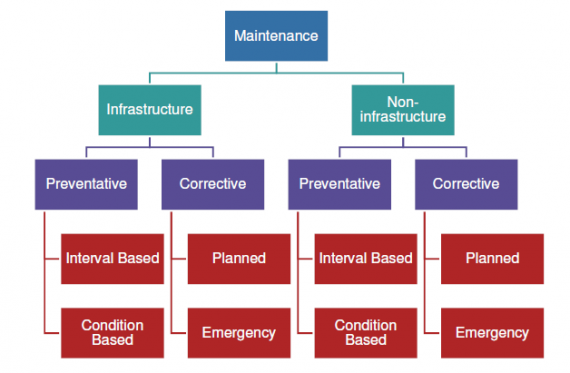1. Introduction
First gazetted into law in 2014, the Municipal Standard Chart of Accounts (mSCOA) was born out of a need to improve municipal financial management in a bid to promote transparency and accountability at municipal level. mSCOA is a standardised accounting system that aims to change how municipalities transact by standardising financial management processes through policy formulation, budgeting, in-year reporting frameworks and statements. The key mSCOA objectives are:
- Improved data quality and credibility
- Improved standardisation
- Uniform datasets
- Standardisation and alignment of government accountability cycle
- Standardised key business processes
- Uniform recording of transactions
- Deeper data analysis and sector comparison
- Standardisation of account classification
On Key has all the functionality to enable a fully mSCOA-compliant municipality. This document outlines On Key’s approach to ensuring that South African municipalities are mSCOA compliant.
2. mSCOA approach
The mSCOA financial reporting regulatory reform represents a business process focused project that standardises all municipal accounting practices and reporting across the country. Every municipality and municipal entity has a chart of accounts that lists all accounts used in the general ledger. The ledger is used by municipal accounting software to aggregate information into an entity’s financial statements. mSCOA targets municipal operations by enforcing a standardisation of municipal account numbers and descriptions in their charts. mSCOA enforces the uniform collection of local government transactional information around seven key segments and 15 fundamental business processes.
The foundation of mSCOA-ready Maintenance Management is the standardisation of processes on the one hand and the definition of accountability and transparency of information across all stakeholder groups on the other.
As with most operations, success lies in the alignment and interaction of Processes, Systems and People. All three of these elements are interdependent on one another in order for the operation to succeed, and in this context, to be mSCOA ready. This document highlights how On Key can support mSCOA, but a successful mSCOA implementation requires robust, consistent processes and a participative workforce.
3.1 Implementation Methodology
As advised by Treasury, an mSCOA steering committee must be in place at municipalities. The committee must ensure an adequate IT infrastructure and network, clear definitions of uniform datasets and single points of entry, and an integrated web enabled systems landscape.
The On Key implementation process consists of four main phases: planning, design, implementation and post go-live support. The process is governed by a quality management system with quality gates at the end of each of the four phases. The mSCOA steering committee will be instrumental in making principle design decisions as part of this process and signing off progress.
Detailed as-is and to-be procedures are workshopped and developed. Based on these a change impact assessment is conducted followed by the development of a training plan for the affected stakeholders. The relevant change management activities have been incorporated into the implementation process.
3.2 Asset Register configuration
The illustration below proposes an On Key Asset Register implementation in support of mSCOA. This is a proposal to serve as input to the On Key implementation team and the mSCOA steering committee.
The Asset Tree hierarchy is a data structure which provides specifics of the given infrastructure down to the component level. The Asset Type Tree hierarchy is a data structure which provides generic asset information that is a combination of functional and asset types information.
The Maintenance Significant Item is the “Unit of Account” level of the Asset Tree. On this level Work Orders will be generated, Failure Analysis recorded and Maintenance budgets configured. Roll-up points can be used to combine multiple proposed Work Orders on a Maintenance Significant Item level up to a single Work Order on a higher level in the Asset Tree.
Components are linked to Maintenance Significant Items for purposes of management of maintenance actions (only).
3.3 mSCOA Segments
The mSCOA design is based on the use of seven segments, being:
- Funding
- Functions
- Municipal Standard Classification/Responsibility
- Project
- Costing
- Regional Indicator
- Item
On Key, as the key Maintenance Management tool, manages and records “maintenance and repair” transactions and costs like labour, material and contracted services. The following part of this document defines how On Key identifies each segment per transaction.
Funding
Funding (prescriptive segment): against which source of funding is the payment allocated and against which source is revenue received?
The mSCOA steering committee will give the necessary guidance, and the On Key implementation team will ensure the necessary segment configuration.
Functions
Function (prescriptive segment): in classifying transactions within this segment, against which function or sub-function should the transaction be recorded?
The mSCOA steering committee will give the necessary guidance, and the On Key implementation team will ensure the necessary segment configuration.
Municipal Standard Classification/Responsibility
Municipal standard classification (not prescriptive segment): against which organisational ward or subward must the transaction be recorded?
The mSCOA steering committee will give the necessary guidance, and the On Key implementation team will ensure the necessary segment configuration.
Project
Project (prescriptive segment): does the transaction relate to a specific project and if so, what type of project?
Operational projects provide a specific category for maintenance. Maintenance is considered a “project” as different cost elements contribute to a municipality’s spending on maintenance. The “elements” provided for in “maintenance” are “employee related cost, materials and supplies and contracted services”. At the highest level, “maintenance” is distinguished based on the “fixed and intangible and infrastructure asset categories”.
Maintenance includes all actions intended to ensure that an asset performs a required function to a specific performance standard(s) over its expected useful life by keeping it in as near as practicable to its original condition, including regular recurring activities to keep the asset operating, but specifically excluding renewal. Maintenance also specifically excludes restoring the condition or performance of an asset following a recognised impairment event, which would be classified as either renewal or upgrading, depending on the circumstances.
Further distinction is made between:
- Preventative Maintenance: Maintenance carried out at predetermined intervals, or corresponding to prescribed criteria, with the intention of reducing the probability of failure or the performance degradation of an item. Preventative Maintenance is planned or carried out on opportunity:
- Interval Based: Maintenance carried out at predetermined intervals.
- Condition Based: Maintenance carried out based on prescribed criteria.
- Corrective Maintenance: Maintenance carried out after a failure has occurred with the intention of restoring an item to a state in which it can perform its required function. Corrective Maintenance can be planned or unplanned:
- Planned: Corrective Maintenance Planned.
- Emergency: Corrective Maintenance Emergency.
On Key’s Type of Work field is a mandatory classification on a Work Order level. On Key’s Type of Work field will be configured with the following values:
| Code | Description | Type |
| 4e28b7a2-dd9c-4ab8-877d-3ed50a9a46e2 | Infrastructure: Preventative Maintenance | Tactical |
| d5b23853-6f0a-40f7-9e98-70f478e4982a | Infrastructure: Corrective Maintenance | Non-Tactical |
| 78be0443-c56c-41df-8a38-5c80b327d578 | Non-infrastructure: Preventative Maintenance | Tactical |
| 50860c00-e3a7-461f-9d7d-0cc8fa722cc6 | Non-infrastructure: Corrective Maintenance | Non-Tactical |
The screenshot below shows a configured profile of the Work Order transaction in On Key with the Type of Work field configured with the mSCOA project segment codes.
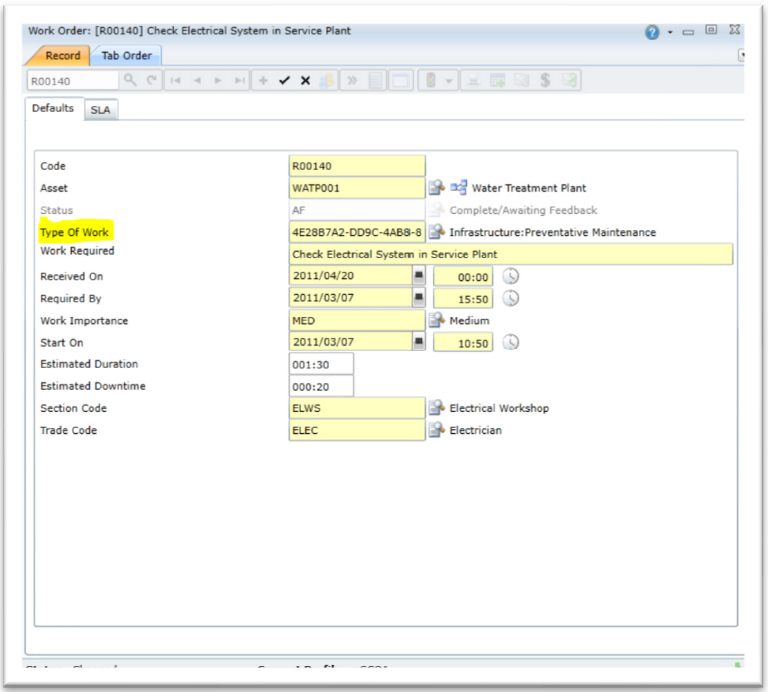
Costing
Costing (prescriptive segment): what is the impact of the transaction on secondary cost drivers, tariffs and/or tariff formulation?
Maintenance costs can broadly be divided into three categories, namely labour, materials and contractors. In most cases, labour and material costs are initially recorded as primary costs within the “Item” segment defined in the Procurement System and funded according to the indicator selected in the “Fund” segment.
The cost indicator within the “Costing” segment marked in On Key provides for the redistribution of these primary costs between functions (no change in the funding source) together with indicators provided in the “Function” segment. The “Project” segment provides the classification link to these indicators and specific projects.
On Key employs the usage-based Costing Methodology when it comes to maintenance costs. Costs are attributed to activities linked to Work Orders.
Distinction is made between “charges to receiving departments and recoveries made by sending departments”. The “sending department” provides goods or services to the “receiving department” based on rates/tariffs determined internally by the municipality in terms of the municipality’s costing methodology. Recording of the transaction in mSCOA thus affects the Function, Costing and Municipal Standard Classification segments.
Default will be applicable within the Regional Indicator, Project, Funding and Item segments. The illustration below attempts to explain the concept in a simplified version not dealing with specific accounts in mSCOA.
- Department providing the service/goods: Debit to the “receiving department” by selecting the appropriate account from the Function and Municipal Standard Classification with the account from “Charges” for the Costing segment.
- Department receiving the service/goods: Credit to the “sender department” by selecting the appropriate account from the Function and Municipal Standard Classification with the account from “Charges” for the Costing segment.
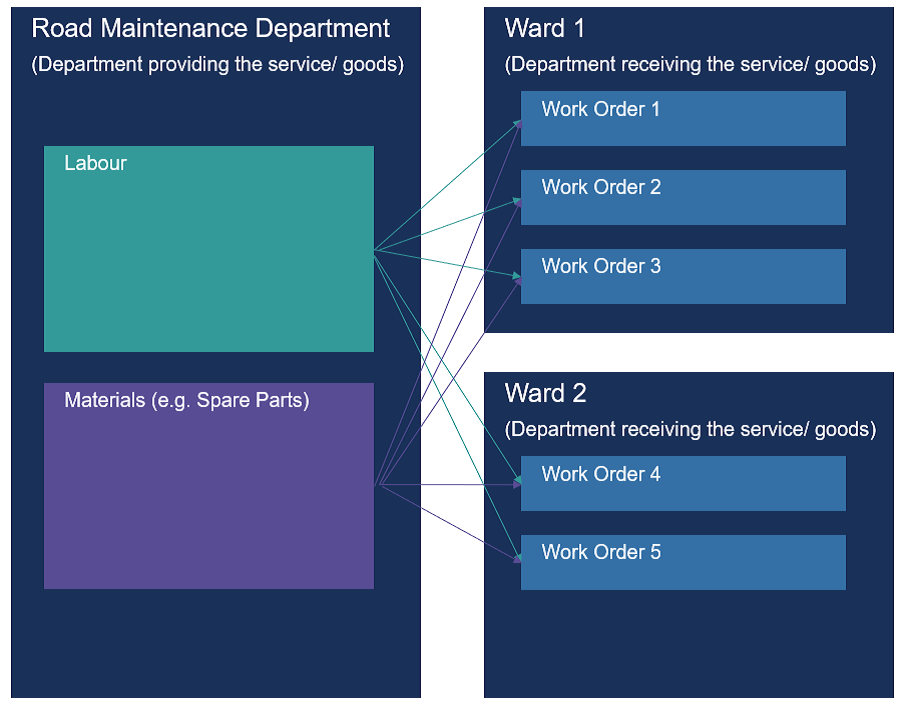
Regional Indicator
Regional indicator (prescriptive segment): which geographical area is deriving the benefit of the related Transaction?
Where the municipality is aware that a particular expenditure should be allocated to multiple regions but does not have the necessary information to decide how it should be divided up amongst them, then the allocation should be to the “Whole of the Metro/Municipality/District Municipality/Ward”, whichever represents ‘the lowest relevant geographical region”.
If personnel are deployed in numerous function/service areas/regional areas, wards, regional offices or districts, etc, for example road maintenance teams, the allocation of compensation should be to either the whole of the municipality or the area.
Item
Item (prescriptive segment): what is the nature of the transaction, e.g. expenditure?
The expenditure classification within the Item segment provides for all possible expense items on “maintenance and repairs” provided for as a project in the Project segment.
The account for “Contractors: Maintenance Unspecified” identifies the “type” of service rendered to the municipality. This is only one type of expenditure that could be incurred as part of the processes for maintaining assets.
Another type of expenditure may be a reallocation of primary cost recognised in the Item Segment Expenditure through the Costing segment, for example cost of using internal staff, materials and supplies issued through the stores.
3.4 System Integration
The maintenance transactions in On Key must be integrated into the financial system to ensure a single dataset for mSCOA compliance. On Key is flexible enough to integrate with any financial system, including:
- SAP
- SAMRAS
The illustration below gives a summary of all the information integration options that could be used with On Key. In this context, the 3rd Party System would be the municipality’s financial system.
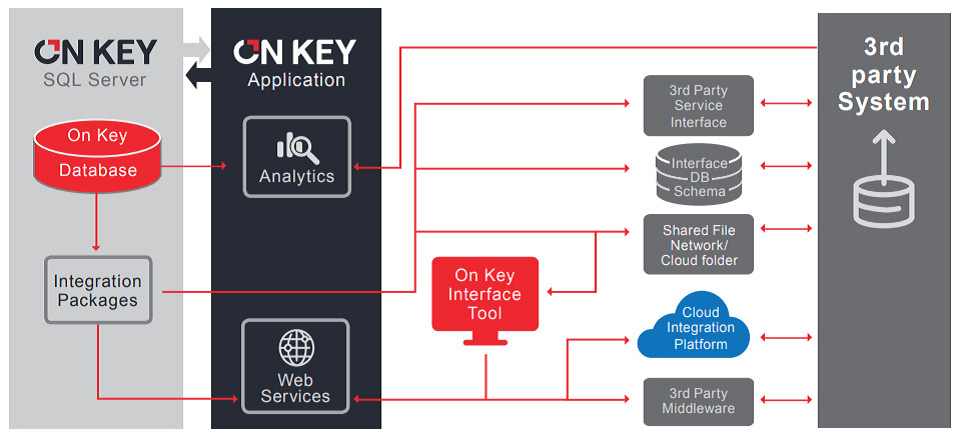
On Key provides two basic integration mechanisms, namely:
- Import/export web services through which the business objects in On Key can be accessed directly by other applications. This allows clients maximum flexibility to shape the On Key integration with other systems.
- A standalone interface tool that allows users to import/export data to and from On Key through a traditional file-based approach. This solution provides a simple, minimal programming option for clients to integrate On Key with other systems that also support file-based interfacing.
The On Key web services have the following characteristics:
- SOAP and REST based web services are provided.
- Import web services support synchronous and asynchronous operation.
- The export web service relies on user definable (Analyser) queries loaded into On Key.
- The same On Key business logic is applied for user interface entries.
The On Key Interface Tool has the following characteristics:
- Uses On Key web services for direct communication with the main On Key application.
- UTF-8 encoded flat files in support of global enterprises with multilingual requirements.
- Comprehensive error and activity log for fault finding.
- Automated fault reporting via e-mail.
- Exports defined by user definable (Analyser) queries loaded into On Key.
In the case of integration required for mSCOA, an integration will be configured that will transfer maintenance transactions to the financial system. The data transfer will include:
- Transaction Date
- Transaction Amount
- Transaction Description
- The seven mSCOA segment codes
- The debit and credit account
